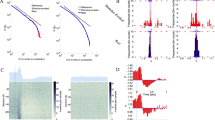Abstract
A mathematical analysis of the variance of the average evoked-response computation as a function of the numberN of stimuli presented is made for the case when the response is disturbed by additive stationary noise. A comparison is made between the variance for purely periodic stimuli and that for stimuli of which the interstimulus durations are Gaussian distributed. In the latter situation, the interval durations may be correlated with each other, e.g. according to a Gaussian Markov process. It is deduced that, in general, the introduction of aperiodic stimulation tends to make the functional relationship between the variance andN behave as though it holds for noise with a very broad frequency spectrum; the variance is proportional to 1/N.
Sommaire
Une analyse mathématique de la variance du potential évoqué moyen comme fonction du nombre de stimulations présentées,N, est dérivée, sous condition que la réponse soit perturbée additivement par bruit de fond stationnaire. On compare la variance en cas de stimulation strictement périodique, et en case de stimulation aléatoire, c'est à dire, si les intervalles entre les stimulations varient selon une distribution Gaussienne. En outre, les intervalles peuvent être corrélés mutuellement, par example conformément un processus Markov-Gaussien. Il est déduit que par l'introduction d'une stimulation apériodique, en général, la relation entre la variance etN s'incline vers le cas d'un bruit de spectre à large bande, donc la variance ètant proportionale à 1/N.
Zusammenfassung
Eine mathematische Analyse der Varianz des gemittelten evozierten Reaktions-potentiales als Funktion der Anzahl von angebotene ReizeN wird dargestellt, unter der Voraussetzung dass der evozierte Potential von additiven stationären Rauschen gestört wird. Es werden verglichen die Varianz wenn die Reize rein periodisch erfolgen und wenn die Zeitintervalle zwischen Reize normal verteilte Schwankungen unterworfen sind. Im letzten Falle dürfen die Zeitintervalle wechselseitig korreliert sein, z.B. gemäss einem Gausschen Markov Prozess. Es wird gezeigt dass im Allgemeinen bei der Einführung von aperiodische Reizfolgen das Funktionalverband zwischen Varianz undN sich dem Falle zustrebt wenn Rauschen mit breitbandigem Leistungsspektrum vorliegt, wobei also die Varianz proportional zu 1/N ist.
Similar content being viewed by others
References
Arnal, D. andGerin, P. (1969a) Etude du bruit résiduel des potentiels évoqués moyens.Electroencephal. Clin. Neurophysiol. 27, 315–321
Arnal, D. andGerin, P. (1969b) Comparaison des potentiels évoqués moyens à l'aide d'un test T2 généralisé. Application au problème de l'interférence des réponses évoqués visuelles successives.Electroencephal. Clin. Neurophysiol. 26, 325–331.
Ball, G. J., Saunders, M. S. andSchnabl, J. (1971) Determination of peripheral sensory nerve conduction velocities in man from stimulus response delays of the cortical evoked potentials.Electroencephal. Clin. Neurophysiol. 30, 409–414.
Barlow, J. S. (1962) Simulation of normal and abnormal electroencephalograms. Quart. Prog. Rept. 65, Res. Lab. Electron., Massachusetts Institute of Technology, Cambridge, Mass., April 15, 221–227.
Barlow, J. S. (1967) Electronic simulation as an aid in evaluating computer-analysed EEG data.Electroencephal. Clin. Neurophysiol. 22, 381–386.
Bendat, J. S. (1964) Mathematical analysis of average response values for non-stationary data.IEEE Trans. BME-11, 72–81.
Daniel, R. S. (1965) Electroencephalographic correlogram ratios and their stability.Science,145, 721–723.
Kitasato, H. andHatsuda, T. (1965) The degree of contamination of averaged response with alpha waves and alpha-like waves evoked by photic stimulation.Jap. J. Physiol. 15, 492–504.
Lee, Y. W. (1960) Statistical theory of communication (Wiley), 284.
Marsoner, H. J. andTatsuno, J. (1970) A method for triggering evoked potentials by a certain component of the background activity.Med. & Biol. Eng. 8, 415–418.
Sato, K. (1957) An interpretation concerning physiological significance of statistical nature of electroencephalograms.Folio Psychiatrica et Neurologica Japonica 10, 283–294.
Sato, K., Kitajima, H., Mimura, K., Hirota, N., Tagawa, Y., andOchi, N. (1971) Cerebral visual evoked potentials in relation to EEG.Electroencephal. Clin. Neurophysiol. 30, 123–138.
Ruchlin, D. S. (1965) An analysis of average response computations based upon aperiodic stimuli.IEEE Trans. BME-12, 87–94.
Weiss, T. F. (1959) InProcessing neuroelectric data, technical report 351, Res. Lab. Electronics, Massachusetts Institute of Technology, Cambridge, Mass.
Wennberg, A. andZetterberg, L. H. (1971) Application of a computer-based model for EEG analysis.Electroencephal. Clin. Neurophysiol. 31, 457–468
Author information
Authors and Affiliations
Rights and permissions
About this article
Cite this article
Ten Hoopen, M., Reuver, H.A. Aspects of average response computation by aperiodic stimulation. Med. & biol. Engng. 10, 621–630 (1972). https://doi.org/10.1007/BF02476079
Received:
Issue Date:
DOI: https://doi.org/10.1007/BF02476079




